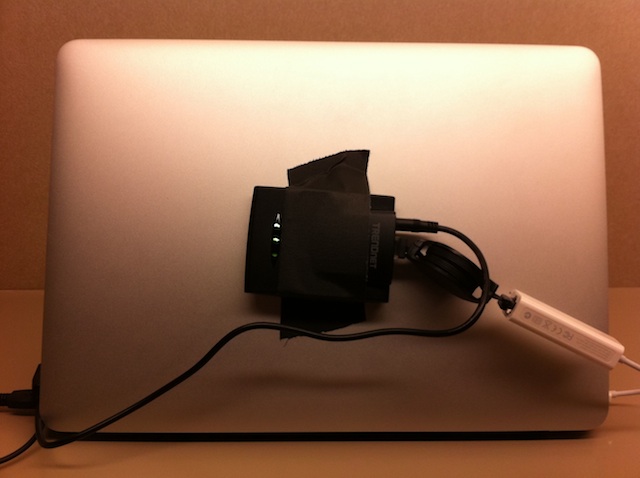Field Notes: Wi-Fi to Wi-Fi routing
I just arrived at my hotel. I’m tired, I’m hungry, and I’ve been offline for over 20 hours. Deep in the bottom of my bag lies an SMC “pocket” router about the size of two packs of smokes. I jack-in and power-up the router. I’m online. I leave my laptop on the desk downloading email while I crash on the bed with my Zaurus PDA; I start surfing for sushi.
Manhattan, NY, Present Day
I just arrived at my hotel. I’m tired, I’m hungry, and I’ve been offline for over 20 minutes (as I approached the city my cab was actually outperforming my 3G data service). Deep in the bottom of my bag lies a TRENDnet “pocket” router about the size of a large matchbook. I jack-in and power-up the router. No link. WTF!
Farewell Ethernet
Worldwide, hotels are dumping their Ethernet ports and offering Wi-Fi only. Some have free Wi-Fi, most don’t. Some assign you an account that can be used with multiple devices, again, most don’t. Most hotels worldwide charge a fee per Wi-Fi device per day.
So far, I’ve been lucky. When I get screwed out of an Ethernet jack for my router I transform my iPhone into a Wi-Fi hotspot and live on 3G. And in most cases that works well, except in midtown Manhattan, parts of San Francisco, and any place outside of the US where data roaming charges would cost more than my daughter’s education.
I’ll wager that other tech travelers have similar issues.
Wi-Fi to Wi-Fi routing
What we need is a Wi-Fi-to-Wi-Fi router. Fortunately, there is a hack for that. Simply connect to the hotel Wi-Fi with your laptop, then share your Internet connection with your Ethernet port (you are probably used to doing it the other way around, but it works both ways, at least with OS/X it does), then connect your router to your Ethernet port. Voilà!
OS/X Tips
For some reason that I am too tired to figure out at this time (I’m still in Manhattan), my OS/X NAT running on my MacBook Air is not providing an IP address via my USB Ethernet adapter to my TRENDnet router. The system log registers the DHCP DISCOVER and that’s it. I checked /etc/bootpd.plist and it looks OK to me. The quick fix was to use my iPad to connect to my router via Wi-Fi and change the WAN (Ethernet) port to “Static IP”. I used ifconfig to find the IP address of the Mac USB Ethernet interface and then added one to that for the router static IP, then I used the Mac USB Ethernet IP for the DNS and default gateway on the router. 30 seconds later all my gear was online.
End Note
This solution is not as ideal as a true Wi-Fi-to-Wi-Fi router, but at least my TRENDnet can be powered by USB so I can still use my laptop anywhere in the room (I just gaffer-taped my router to my MacBook Air lid. You should always travel with gaffers tape. Do NOT use duck tape on your precious Mac).
